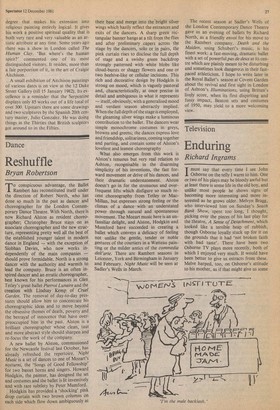Reshuffle
Bryan Robertson
To conspicuous advantage, the Ballet Rambert has reconstituted itself under the direction of Robert North, who has done so much in the past as dancer and choreographer for the London Contemporary Dance Theatre. With North, there is now Richard Alston as resident choreographer; Christopher Bruce stays on as associate choreographer and the new structure, representing pretty well all the best of the established younger talent in modern dance in England — with the exception of Siobhan Davies, who now works independently of the main companies — should prove formidable. North is a strong dancer with the authority and warmth to lead the company. Bruce is an often inspired dancer and an erratic choreographer, best known for his performances in Glen Tetley's great ballet Pierrot Lunaire and the creation with Lindsay Kemp of Cruel Garden. The removal of day-to-day pressures should allow him to concentrate his choreographic ideas and to move beyond the obsessive themes of death, poverty and the betrayal of innocence that have overpreoccupied him in the past. Alston is a brilliant choreographer whose clean, taut and more abstract style should sharpen and re-focus the work of the company.
A new ballet by Alston, commissioned for the Newcastle festival last October, has already refreshed the repertoire. Night Music is a set of dances to one of Mozart's notturni, the 'Songs of Good Fellowship' for two basset horns and singers. Howard Hodgkin, the painter, has designed the set and costumes and the ballet is lit inventively and with rare subtlety by Peter Mumford.
Hodgkin has provided a 'shocking' pink drop curtain with two brown columns on each side which flow down ambiguously at their base and merge into the' bright silver wings which hazily reflect the entrances and exits of the dancers. A sharp green rectangular banner hangs at a tilt from the flies and after preliminary capers across the stage by the dancers, solo or in pairs, the pink curtain rises to disclose the full depth of stage and a swishy green backdrop strongly patterned with white blobs like cloud-bursts or shaggy flowers and one or two beehive-like or cellular incisions. This rich and decorative design by Hodgkin is strong on mood, which is vaguely pastoral and, characteristically, at once precise in detail and ambiguous in what it represents — itself, obviously, with a generalised mood and verdant season abstractly implied. When the full depth of the stage is employed, the gleaming silver wings make a luminous contribution to the ballet. The dancers wear simple monochrome costumes in greys, browns and greens; the dances express love and friendship, solitariness, coming together and parting, and contain some of Alston's loveliest and leanest choreography What also emerges from this work is Alston's tenuous but very real relation to Ashton, recognisable in the disarming simplicity of his inventions, the fast forward movement or drive of his dances, and their dramatic understatement. Alston doesn't go in for the strenuous and overfrequent lifts which disfigure so much recent choreography from Tetley or MacMillan, but expresses strong feeling or the climax of a dance with an understated power through natural and spontaneous movement. The Mozart music here is an unfamiliar delight, and Alston, Hodgkin and Mumford have succeeded in creating a ballet which conveys a delicacy of feeling not unlike the gentle, tender or noble gestures of the courtiers in a Watteau painting or the milder antics of the cornmedia dell'arte. There are Rambert seasons in Leicester, York and Birmingham in January and February. Night Music will be seen at Sadler's Wells in March. The recent season at Sadler's Wells of the London Contemporary Dance Theatre gave us an evening of ballets by Richard North, as a friendly envoi for his move to the Rambert company. Death and the Maiden, using Schubert's music, is his finest work: a fast-moving, dramatic ballet with a set of powerful pas de deux at its centre which are plainly meant to be disturbing and sometimes look dangerous in their fastpaced athleticism. I hope to write later in the Royal Ballet's season at Covent Garden about the revival and first sight in London of Ashton's Illuminations, using Britten's lively score, when its first dispiriting and fussy impact, Beaton sets and costumes of 1950, may yield to a more welcoming view.






































 Previous page
Previous page